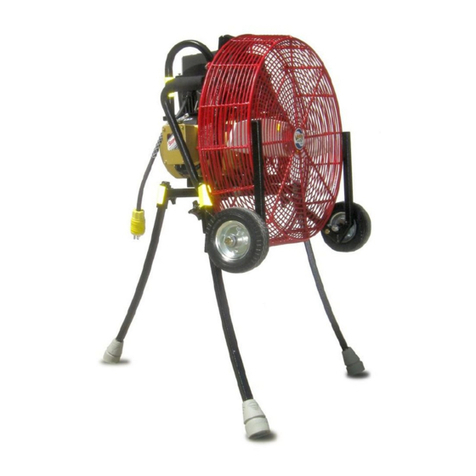
*HP (HORSEPOWER): specs show correct HP ratingsVFENTRY AN
but many other PPV fan manufacturers continue to publish pre-2007
values. Long ago, litigation changed the way Honda and other small
engine manufacturers rated HP. When comparing fans, if the fans’
engines are equal in make and model, the engines are equal in
power, even if the HP ratings shown do not match.
Air volume is a much better indicator of fan performance(output)
than engine horsepower . However, because air volume is(input)
measured inconsistently in the industry, comparing published CFM
values is largely meaningless and in many cases misleading. We
encourage hands-on and side-
by-side testing and can arrange
no-risk free trials to facilitate
this. Hands-on demos make
other big differences in fans
obvious, like relative weight,
noise, emissions, and versatility.
Pg 1 of 2
THRUST: Based on Newton’s third law of motion, thrust is a
measure of fan performance that allows easy comparison
of fans, with far fewer variables than direct measure of CFM.
Simple instructions available upon request.
VOLUME: Air volume, in cubic feet per minute (CFM), is
measured on with the legs extended. MultiplyVF
ENTRY ANS
by 1.69875 to convert this to meters cubed per hour (m /h).
3
CARBON MONOXIDE: All models’ CO output atVFENTRY AN
equilibrium are well below OSHA standards of 50 PPM.
HONDA GC- VERSUS GX-SERIES ENGINES. The GC160
motor is an economy option, rated as residential duty, while
the heavier duty Honda GX series motors (GX120, GX160,
GX200) are rated commercial duty. GX motors also have
cast iron bores instead of aluminum, low-oil shut off
protection, an on/off switch separate from the throttle, and
a fuel shut-off valve. Warranties also differ (see Table 1).
Ventry Solutions, Inc.
(888) 257-8967 | 208-773-1194
Fax (208) 777-0360 | info@ventry.com
14128 N Hauser Lake Rd, Hauser, ID 83854
VENTRY COM.
VENTRY SOLUTIONS, INC. • (888)257-8967 • ventry.com 20170322 Fan Specs
SPECIFICATIONS
ALL-TERRAIN
PPV FANS ®
MOTOR MAKE HP RATINGS
& MODEL Pre-2007 Now
Honda GX120 4 hp 3.5 hpà
Honda GC160 5 hp 4.6 hpà
Honda GX160 5.5 hp 4.8 hpà
Honda GX200 6.5 hp 5.5 hpà
Table 2
Table 1
¸Measurement not yet available.
Patent 5,503,526
WARRANTY. VFENTRY ANS
come with lifetime factory
support. Also, workmanship
and materials are covered on
all for five years.VF
ENTRY ANS
Our customers have deemed
this our “No BS” warranty.
No matter your fan’s age or
origin, if you ever have
questions, please contact us
and we will help!
FEATURES OF ALL VENTRY FANS®
VOLUME THRUST CO FUEL RUN TIME ENGINE/MOTOR WARRANTY
MODEL TYPE PROP MOTOR/ENG. HP* (CFM) (LBS) (PPM) CAPACITY /TANK Commercial/Institutional Use
20EM3550 Electric 20 Baldor EM3550 1.5 10,500 8. 0 N/A N/A Motor 18 mos; Drive 18 mos1
®
20GX120 ®
Gas 20 Honda GX120 3.5 16,500 12.7 17 2.1 qts 1.8 hrs Engine: 3 years
20GC160 ¸Gas 20 Honda GC160 4.6 17,000 13.5 1.9 qts 1.5 hrs Engine: 3 months
20GX160 ¸Gas 20 Honda GX160 4.8 17,300 14.4 3.3 qts 2.0 hrs Engine: 3 years
24GX120 Gas 24 Honda GX120 3.5 20,000 17.6 16 2.1 qts 1.8 hrs Engine: 3 years
24GC160 Gas 24 Honda GC160 4.6 23,800 19.7 30 1.9 qts 1.5 hrs Engine: 3 months
24GX160 Gas 24 Honda GX160 4.8 24,000 19.8 32 3.3 qts 2.0 hrs Engine: 3 years
24GX200 Gas 24 Honda GX200 5.5 29,500 24.4 19 3.3 qts 1.7 hrs Engine: 3 years






























